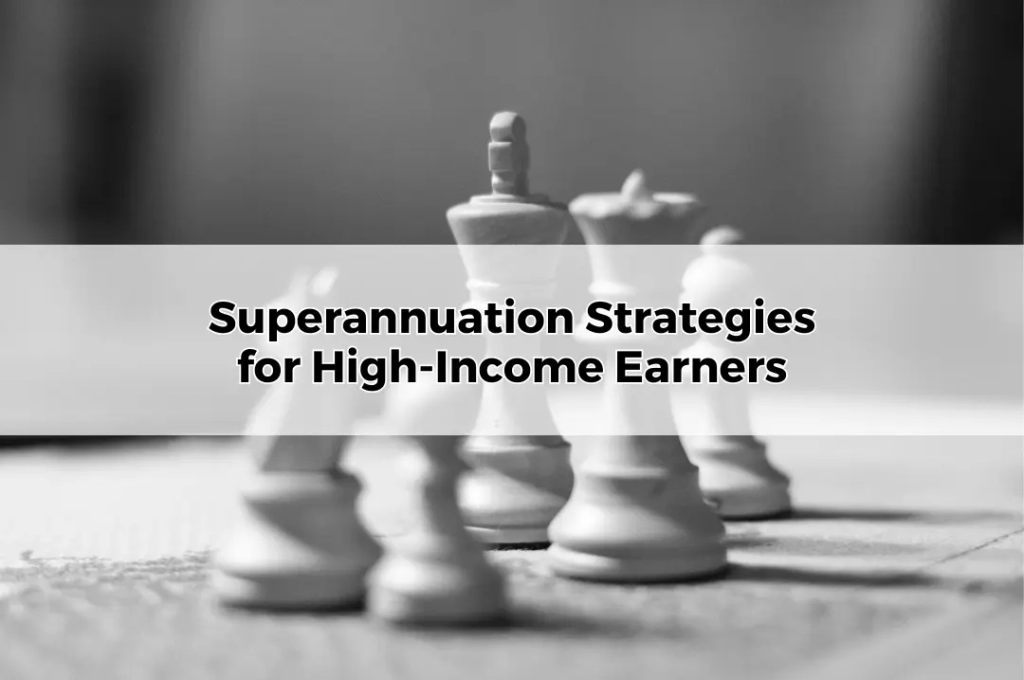Superannuation Strategies for High-Income Earners
Table of Contents
ToggleThe Importance of Superannuation for High-Income Earners
Superannuation is a cornerstone of retirement planning, particularly for high-income earners. Ensuring a comfortable retirement lifestyle requires more than just saving; it involves strategic planning and smart investment choices. High-income earners, in particular, have unique opportunities and challenges when it comes to maximising their superannuation benefits.
Understanding the Contribution Caps
Maximising concessional contributions is a pivotal strategy. These pre-tax contributions, including employer contributions and salary sacrifice amounts, are capped at $30,000 from 1 July 2024. Exceeding this cap results in additional tax liabilities, making it crucial to stay within limits. Understanding and leveraging these caps can significantly enhance your superannuation balance.
Boosting Your Super with After-Tax Contributions
Utilising non-concessional contributions allows high-income earners to boost their super with after-tax dollars. The annual cap for these contributions is $110,000, but individuals under 67 can bring forward up to three years’ worth of contributions, allowing a total of $330,000. This strategy can rapidly increase your super balance, especially if you have received a windfall or other substantial income.
Taking Advantage of Unused Cap Space
Catch-up contributions provide an excellent opportunity for those who have not maximised their concessional contributions in previous years. If your total super balance is less than $500,000, you can carry forward unused cap space from the past five years. This strategy is particularly beneficial for high-income earners with fluctuating incomes, enabling them to make larger contributions in high-income years.
How Pre-Tax Contributions Can Benefit You
Salary sacrificing is a tax-effective way to grow your superannuation. By redirecting a portion of your pre-tax salary into your super fund, you reduce your taxable income, which can lead to significant tax savings. This strategy not only boosts your retirement savings but also provides immediate tax benefits.
Enhancing Super Benefits for Your Partner
Spouse contributions can be a valuable strategy for couples looking to maximise their combined superannuation benefits. By contributing to your spouse’s super fund, you can potentially receive a tax offset while increasing your partner’s retirement savings. This approach is especially useful if there is a significant income disparity between partners.
Greater Control and Flexibility
Self-Managed Super Funds (SMSFs) offer high-income earners greater control over their superannuation investments. With an SMSF, you can tailor your investment strategy to suit your financial goals and risk tolerance. While SMSFs require a significant commitment of time and resources, the potential for higher returns and personalised investment choices can be worth the effort.
Diversifying Your Super Portfolio
Investment strategies within super are crucial for maximising growth and minimising risk. Diversification across asset classes—such as shares, property, and fixed income—can protect your super balance from market volatility. High-income earners should consider their investment time horizon and risk tolerance when selecting super investments to ensure a balanced and robust portfolio.
Reducing Your Taxable Income
The tax benefits of super contributions are substantial. Concessional contributions are taxed at a lower rate of 15%, compared to the marginal tax rate, which can be as high as 47% for high-income earners. This differential provides significant tax savings and accelerates the growth of your superannuation.
Protecting Your Wealth for Future Generations
Superannuation and estate planning go hand in hand. Ensuring that your superannuation benefits are passed on to your beneficiaries in the most tax-effective manner requires careful planning. Nominating beneficiaries and considering reversionary pensions can help protect your wealth and provide for your loved ones after your passing.
Maximising Benefits as You Approach Retirement
The transition to retirement strategy allows individuals aged 60 and above to draw down from their super while still working. This strategy can provide additional income and reduce working hours without significantly impacting your retirement savings. It’s a flexible approach that can ease the shift from full-time work to retirement.
Leveraging Expertise for Optimal Super Strategies
The role of professional advice cannot be overstated. Financial advisers can provide tailored strategies to maximise your superannuation benefits, ensure compliance with regulations, and optimise tax outcomes. Engaging with an expert can significantly enhance your retirement planning and provide peace of mind.
Staying Informed About Policy Shifts
Legislative changes and superannuation are closely linked. Staying informed about policy shifts is crucial for high-income earners to adapt their strategies accordingly. Regularly reviewing and adjusting your superannuation plan in response to legislative changes ensures that you remain compliant and maximise available benefits.
Building a Robust Superannuation Plan
Building a robust superannuation plan involves a combination of strategic contributions, smart investments, and proactive planning. High-income earners have unique opportunities to maximise their superannuation benefits and secure a comfortable retirement. By implementing these strategies and seeking professional advice, you can navigate the complexities of superannuation with confidence and foresight.









